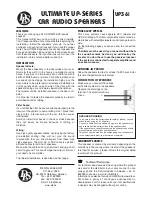
CONNECTING THE SPEAKER
1. Separate the two conductors of the speaker wire so that at least two inches
of each conductor are free.
2. Strip one half inch of insulation from the end of each conductor of the
speaker wire.
3. If you have any connectors (gold pins or bananas) which you prefer to use,
affix them to the stripped wire ends now. Only gold plated connectors should
be used outside as they will not tarnish or corrode.
4. Use the bracket knobs to attach the speaker to the bracket. Do not tight-
en the knobs completely. Angle the speaker so that the rear terminals are
accessible.
5. Connect one stripped wire end (or connector) to the black and one to the
red terminal. Pay attention to the markings on the wire. Each speaker must be
connected to the amplifier in the same way.
SPEAKER PHASE
Speaker wire has two conductors. One conductor is attached to the negative (-)
terminals and one conductor is attached to the positive (+) terminals of both
your speaker and your amplifier. Usually, the wire is marked for your conve-
nience. There are different ways to mark the wire; a stripe on one wire, a
ribbed area of one conductor you can only feel, different colors of metal wire
on each conductor, or there might be a fabric strand or string wound into one
of the conductors. Of course, there are some wires which appear completely
identical. Be careful to avoid mistakes. If you do, one speaker will be playing
out of “phase” with the other speaker. An out-of-phase pair of speakers work
against each other and the sound of the two speakers playing together will be
lacking in bass and “phasey” sounding. If you suspect the sound is not right
and you cannot see any markings on the wire, try this simple test:
1. Point the speakers at each other, rather than at you.
2. Play some music with the amplifier or radio set to Mono.
INST
ALLA
TION
16
DS00215A/OS6 Manual 3/1/99 9:19 AM Page 8








































